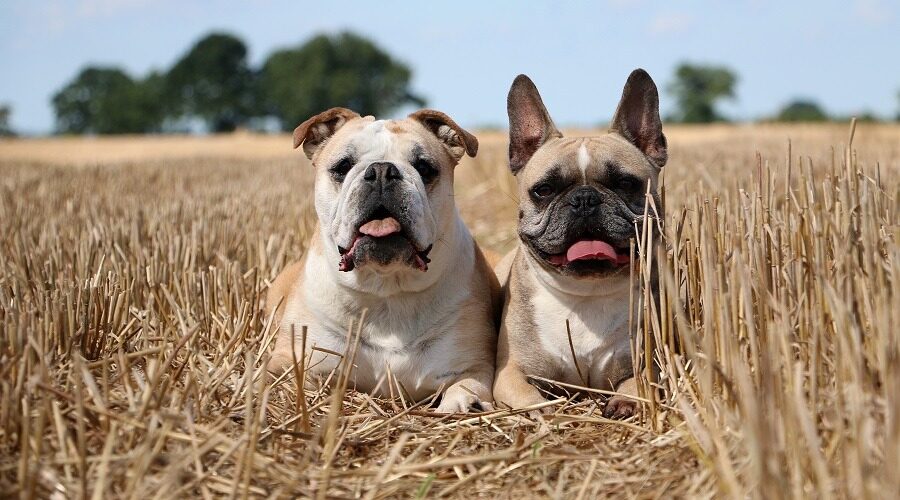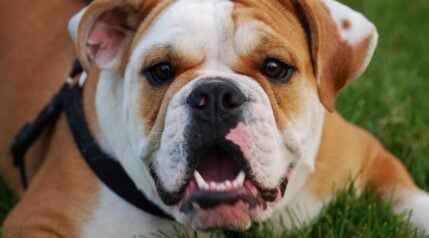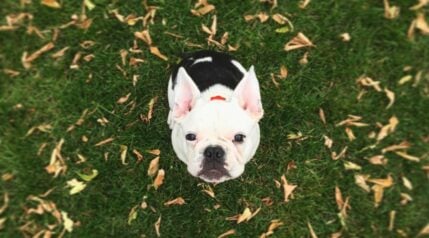The French Bulldog and the English Bulldog are remarkably similar pups with a few notable differences. Being relatives, their similarities are uncanny, and with their cute wrinkly faces and sociable nature, they make for brilliant family pets that everyone will adore. The French Bulldog is a more compact and streamlined version of the English Bulldog. There are a few other differences between the French Bulldog vs. English Bulldog.
The French Bulldog’s most distinguishable feature is its tall bat-like ears. The English Bulldog’s most distinguishable feature is rolled skin that droops down either side of the face. There is a lot more to both of these breeds than physical features, though. While both are lovable, adorable pups, they have differing care and energy needs.
So, whether you are trying to decide between choosing the medium-sized English Bulldog, or the small-sized French Bulldog, read on to find out the finer details that will undoubtedly help you to make your final decision.
Breed Comparison
French Bulldog
- Height 11-12 Inches
- Weight 20-28 Pounds
- Temperament Playful, Smart, Adaptable
- Energy Low
- Health Below Average
- Lifespan 10-14 Years
- Price $1,500 and Up
English Bulldog
- Height 14-15 Inches
- Weight 40-60 Pounds
- Temperament Friendly, Courageous, Calm
- Energy Low
- Health Below Average
- Lifespan 8-10 Years
- Price $1,500 and Up
Key Differences
- French Bulldogs are smaller, reaching 20 to 28 pounds.
- English Bulldogs are larger, reaching 40 to 60 pounds.
- Frenchies live longer, with a life span of 10 to 14 years. English Bulldogs live 8 to 10 years.
- Engish Bulldogs have droopy skin on their faces.
- Frenchies have signature “bat ears.”
- English Bulldogs have slightly rougher hair.
- Frenchies are more energetic and demanding of attention.
- English Bulldogs can be more stubborn.
Breed History
The French Bulldog is a descendant of the notably larger English Bulldog. However, their historical journey separated when the French Bulldog left England for a much warmer climate in France.
French Bulldog

Despite the name, the French Bulldog is not French. This pup hails from England. In the mid-19th Century, smaller English Bulldogs became extremely popular with the lace traders in central England, particularly around the markets of Nottingham. When the demand for their lace decreased in England, the traders set sail across the Channel to the northern French countryside with their pups in tow. Almost as soon as the breed landed, the smaller Bulldog became an instant hit.
Over several decades, these pups were crossed with other smaller breeds, such as the Pug and possibly other Terrier-type dogs. They then gradually found their way into the laps of the French aristocracy in Paris and other rich cities. The Frenchie is commonly mistaken for the Boston Terrier.
Towards the end of the 19th Century, the Frenchie became popular across Europe and America, It was the Americans who insisted that the breed keep the iconic bat ears. However, popularity never took off in England, as the English nation was very protective of their English Bulldog, and they felt the French Bulldog’s popularity might threaten their national symbol.
The Frenchie is still very popular, and thanks to those adorably alternative features and playful persona, the American Kennel Club (AKC), in 2022, ranked Frenchies as the most popular dog breed in America.
English Bulldog

It is believed that the English Bulldog was developed in the 13th Century in England for the purposes of bull baiting. The English Bulldog in those days was ferocious, and their jaws were tremendously strong, and it seemed that he could never be injured in the ring.
In 1835, this cruel blood sport was made illegal, and the fighting went underground. Spectators wanted a more agile dog, so they bred English Bulldogs with Terriers. This was when American Pitbull Terriers, and many other fighting dogs, were born.
The English Bulldog became unemployed, and in an attempt to save the breed from extinction, fanciers bred them to be more gentle and sweeter in their temperament.
The once thuggish canine soon became a lovable rogue who makes a great family pet. This adorable breed is now the face of many companies and famous sports teams across the world. The Frenchie is probably most famous for being closely linked with one of England’s Prime Ministers, Sir Winston Churchill. The breed was known to many nations as the “British Bulldog.” Tenacious with unrelenting courage, with a stern but droopy smile being their main similarities.
Appearance
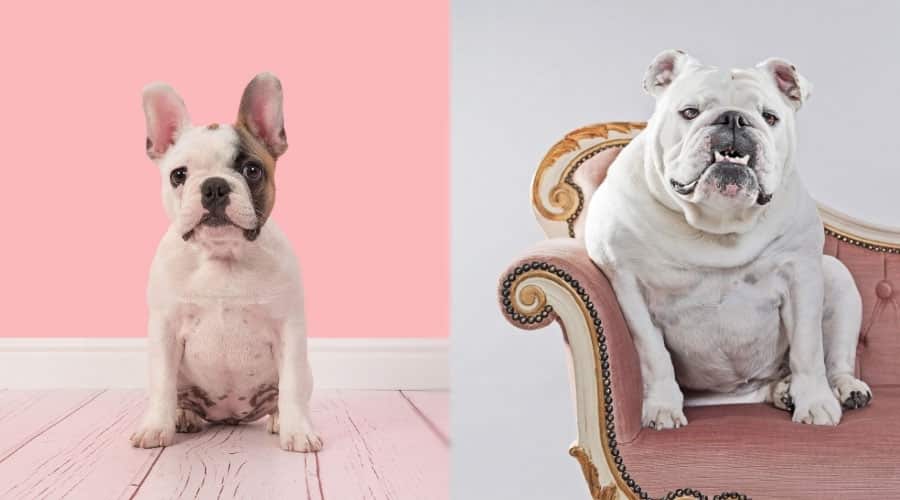
The English Bulldog is the classic Bulldog, whereas the French Bulldog is an altered and, some would say, prettier version with more delicate features. The Bulldog has a wider and meatier head held by a strong and sturdy neck, compared to the French Bulldog, who has a much smaller head that is held by a thinner and longer neck. The Bulldog’s eyes are slightly smaller but are set wider apart compared to the rounder eyes of the French Bulldog.
It is the ears and the skin that are the most notable difference between the two. The French Bulldog has tall and erect ears that resemble a bat, whereas the English Bulldog’s ears are set on the side of the skull and drop down into a rose shape.
English Bulldogs more closely resemble a pug, while French Bulldogs do not. The French Bulldog’s skin is much tighter, and he has fewer folds, with a few situated just above the muzzle between the nose and eyes. The English Bulldog has droopy chops that fall from the side of the nose and overhang the lower jaw on both sides.
It is their size difference that is the most notable difference between the two breeds. The French Bulldog measures 11 to 13 inches in height, whereas the English Bulldog measures 14 to 15 inches. The French Bulldog also weighs much less, with 28 pounds being the maximum weight in both males and females.
The English Bulldog weighs anywhere between 40 and 50 pounds, which means he can weigh almost double compared to the Frenchie. The English Bulldog is square in stature and is much more squat and stockier, whereas the French Bulldog is slightly more in proportion.
They share a similar coat that is short and smooth, but the English Bulldog has a wider variety of coat colors. They also tend to have a curly tail similar to that of a pig. On occasion, they will both have a corkscrew tail, which is slightly different than a curly tail, but reputable breeders will not breed dogs with this type of tail as it tends to come hand in hand with spinal problems.
Despite their differences, they are funky-looking dogs, and it is their flat faces and large puppy dog eyes that win hearts across the globe.
Temperament

The French Bulldog and the English Bulldog are both sociable creatures who crave human attention. They both love to snooze on their master’s lap. Because they are so sociable, neither of them likes to be alone for long periods of time. As such, both breeds often develop separation anxiety.
The French Bulldog and the English Bulldog both make unforgettable family pets. Their small size and incredibly gentle and patient nature mean that they are perfect for children who are learning how to look after and handle a dog. But, as with any dog, children should have supervision when interacting with them.
The French Bulldog is more of a fun-loving pup who constantly likes to be the center of attention. They are silly and love to show off their clown antics. The English Bulldog is much more relaxed, and it would be safe to suggest one of the most laid-back dogs in the canine kingdom. Although this pup loves to have fun, they will do so laying upside down with their belly and legs in the air, expecting their owner to do all of the hard work.
Exercise
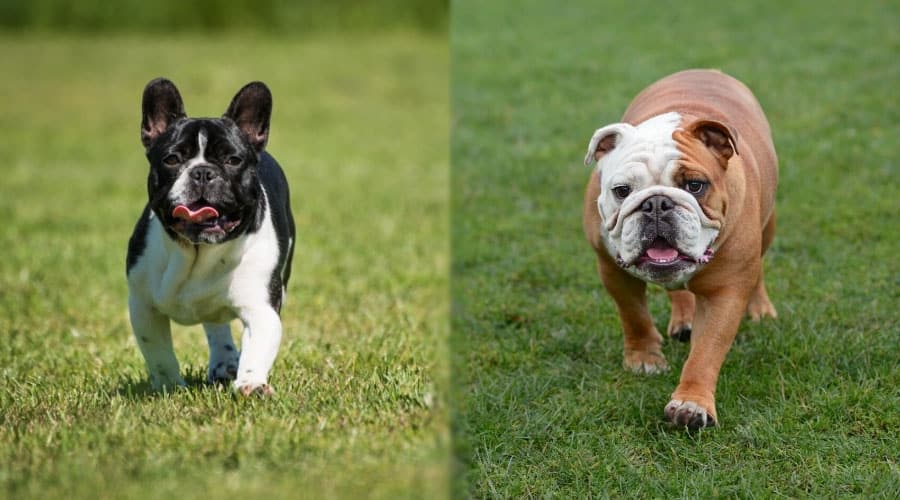
The French Bulldog and the English Bulldog are very similar in their energy levels in that they are both low-energy pups who are super nonchalant. They will both only need around 20 to 30 minutes of exercise a day, all of which can be a walk around the block for a leg stretch and a toilet break. Neither of these Bullies requires intense exercise, and they are both happy to chill and nap all day long.
Because they are both brachycephalic dogs, neither of them copes very well in the humidity or heat, so be sure not to exercise them on warm days. Their exercise needs will have to be adjusted, and ideally, they should take a walk either early morning or late evening when it is much cooler.
Training

The French Bulldog is intelligent and will pick up commands quite easily. However, the Frenchie is also famous for being independent, so you need to be consistent with your training. Do not give in to that stubbornness, for once you start to give up, you will never win the training battle again. If you plan to train walking with a harness, make sure the harness is the right size.
And then there is the English Bulldog, notably one of the most stubborn creatures on this planet. Lazy and stubborn is a difficult combination to master, and for this reason, this breed is not for a first-time dog owner.
If it is important for you to have a fully obedient pup, then the Bulldog is not the one for you. Some days they will listen. Some days they will not, and rarely do owners go a full week without begging their pups to walk home along the sidewalk instead of sitting on the path like a lump on a log. Bulldogs also require harnesses that fit correctly, or leash training can be difficult.
The French Bulldog and the English Bulldog must be socialized early to ensure that they are comfortable in new situations and with new people and animals.
Health
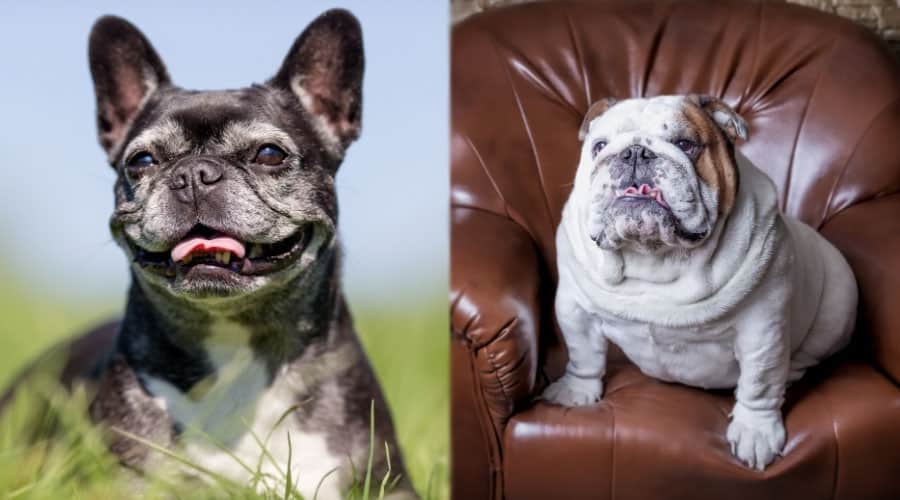
The most important health issue to be aware of when it comes to the French Bulldog and the English Bulldog is Brachycephalic Syndrome. This is caused by their flat faces and poor respiratory structure, which causes issues with their heat control and their breathing. During warm days, be sure to monitor them, ensure they are in a cool and airy space, and that they have plenty of water.
While the English Bulldog National Breed Club does not recommend any particular testing, the breed suffers similar health issues to the French Bulldog. The National Breed Club suggests that this breed have screenings for the following health concerns:
Hip Dysplasia – An abnormal formation of the elbow and hip joints that can cause painful arthritis in later life.
Patella Evaluation – Where the kneecap pops out of place, and it can be extremely painful to walk on.
Ophthalmologist Evaluation – This evaluation screens for a list of eye issues, such as Progressive Retinal Atrophy, Entropion, and a defect known as ‘Cherry Eye,’ to name a few.
Cardiac Evaluation – This evaluation screens for a list of heart defects.
They are also both prone to develop a long list of skin allergies, such as Demodectic mange, Staph infection, and other general allergies, itchy skin, and yeast infections. The French Bulldog, because of those large, erect ears that catch a lot of dirt, often develops ear infections. The English Bulldog sometimes develops head tremors.
Overall, the English Bulldog lives between 8 to 10 years, whereas the French Bulldog lives longer between 10 to 12 years. They are both prone to suffer a longer list of health problems compared to the average pup, and this is a serious factor to consider if you are thinking about welcoming one of these breeds into your home.
Nutrition

The French Bulldog consumes around 1 ½ cups of food a day, whereas the English Bulldog will eat around two cups of food a day. It is important to hide food out of their reach, as they will both eat everything in sight. Also, be mindful to monitor their treat intake, particularly the English Bulldog, because they can become obese.
Because of their vast amount of skin allergies and other health issues, it is crucial to ask the veterinarian about what to feed them both, as they may require a special diet or a particular kibble to alleviate the symptoms.
Grooming

The French Bulldog and the English Bulldog have similar grooming needs. They both only require occasional baths as long as they don’t get too dirty exercising. Once every 2 or 3 months will be adequate.
Because of their skin allergies, be sure to use gentle products, and refrain from washing them more than the recommended amount, as you risk damaging their natural coat oils and sensitive skin.
The French Bulldog and the English Bulldog both have short coats that will only require brushing once a week, and this is simply to keep them looking shiny and healthy. They both shed when the months start to warm up.
Despite being relatively easy to care for when it comes to their bathing and brushing, their skin folds and rolls do require a little extra attention than the average dog. They can often emit a musty canine smell if not cared for properly, and while you should stick to the recommended amount. Washing them thoroughly and also drying them thoroughly is the key. It is important to clean between each wrinkle and fold with a special cleaning solution and a cotton bud in order to stop sores and infections from developing.
Puppy Price

The French Bulldog’s popularity has increased quite significantly in the last decade, much more steadily than the English Bulldog, whose popularity has been more stable, and as such French Bulldogs are currently slightly more expensive.
The average price of a French Bulldog will start from around $1,800, whereas the English Bulldog will start from around $1,500. Of course, the more desirable their characteristics or being born from an award-winning lineage means that you can expect to pay much more than the average price.
Final Thoughts
There is no escaping the fact that both Bulldog breeds are adorable in their own way, and though they might look different from one another, you can see that they are definitely related. The French Bulldog is much smaller in size but is much more mischievous and playful in temperament. The English Bulldog is a slower-moving pup and more laid back.
Whichever pup you prefer, or whoever will suit your lifestyle better, they are both fun-loving and affectionate dogs that everyone will adore.

